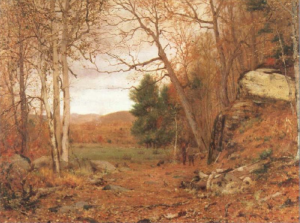Jervis McEntee’s “Autumn Landscape,” 1867
“I start with no new vows or resolutions but with a fervent hope that I may be diligent, truthful and able to resist temptation in whatever form and to have the courage and the will to live up to my ideal of a true life.” — Painter Jervis McEntee’s diary entry from January 1, 1883
Jervis McEntee was a member of the Hudson River School of American painters, a mid-19th century art movement known for romantic, poetic landscape paintings. McEntee’s works frequently feature autumnal subject matter and an earth-toned palette, which lends his work a melancholic air. “Some people call my landscapes gloomy and disagreeable,” McEntee wrote in his journal. “They say that I paint the sorrowful side of Nature, that I am attracted by the shadows more than by the sunshine. But this is a mistake. I would not reproduce a late November scene if it saddened me or seemed sad to me. In that season of the year Nature is not sad to me, but quiet, pensive, restful. She is not dying, but resting.”
While McEntee never had the success of some of the better-known members of the group, such as Frederic Edwin Church and Albert Bierstadt, he was a close friend and traveling companion to major Hudson River School artists. Though best known for his quiet and solitary paintings, McEntee socialized regularly with other artists. He and his wife Gertrude, a singer, welcomed many painters, writers and performers into their home. Together they encouraged the arts in America much as French salonnières of the 17th and 18th century had done.
Upon McEntee’s death, his mentor Frederic Church wrote to the painter’s sister, saying, “You have lost a brother and I a lifelong friend—a man pure, upright and as modest as he was gifted.” McEntee kept detailed diaries describing his interactions with artists, his travels, exhibitions and prices of paintings sold at them and his chronic economic woes. While I find his paintings evocative and moving, he is today best appreciated for his diaries, which are kept in the Smithsonian Institution’s Archives of American Art. They give rich and fascinating insights into the lives of 19th-century American artists.
2980 Total Views 1 Views Today

